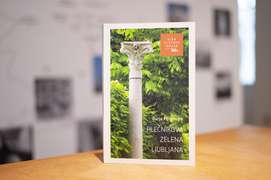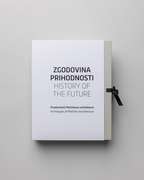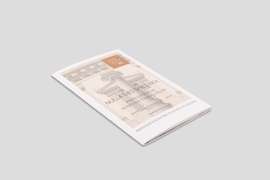Spatial Concepts of Plečnik’s Renovations [SOLD OUT]
The exhibition’s catalogue is a summary of a two-year research project by the students of the Faculty of Architecture, who, under the mentorship of Prof. Maruša Zorec and Andraž Keršič, explored and studied various Plečnik’s approaches towards renovations. Public spaces, such as Šance at Ljubljana Castle, the Roman Wall at Mirje, the Križanke complex, and a number of restorations of sacred buildings that the architect revitalised, still stand out as radical and critical conceptual reflections on the restoration of monuments. The students explained the concepts of these renovations through study drawings, diagrams, and schemes, accompanied by archival materials. The catalogue is complemented by a reflection on Plečnik’s approaches to renovation by the exhibition curator and conservator Tatjana Adamič.
The authors, Prof. Maruša Zorec and Andraž Keršič, write in the introductory text:
“After his arrival in Ljubljana, Plečnik began to work on the city spaces and campaign for the decaying monuments, ruins, and inaccessible spaces, too narrow for users’ needs. His radical renovations and a contemporary conceptual approach rearranged them into comprehensive entities. Due to his interventions, monuments were preserved, and nowadays, they create an indivisible historical whole. The methods used by Plečnik in his renovations illustrate interesting and fresh spatial concepts that are still relevant today. His renovations were most often a collaboration with the art historian and conservator France Stele and later with Nace Šumi, Stele’s student. Plečnik’s compositions with new public programmes create a multi-layered open space for the general public. He unveiled views of the city from the ruins at Šance. The Roman Wall was incorporated into the living organism of a fast-growing city through openings and a park, while the previously completely closed-off Križanke monastery was radically opened. With the latter, Plečnik graduated the levels and sizes of public spaces and reinvented them as the heart of the city quarter with its young users.
Sacred space is a special chapter in Plečnik’s oeuvre. The incredibly contemporary church spaces express the basic equality of the church’s audience. This was typical in Early Christian churches, which Plečnik visited during his travels across Italy and Istria. This type of a church space, which was radically different before the Second Vatican Council, can be found in numerous plans and church renovations within his oeuvre. Some approaches fully incorporate the existing substance and overturn its limits. Especially delicate are the interventions in which the architect is saving damaged monuments, is reconstructing ruins and fragments, or is changing the logic of the given spatial bases. Even with smaller interventions, some almost on the scale of internal furnishing, he is balancing and emphasising features of existing ambiences, transforming them into completely contemporary spaces."
Published by: Museum and Galleries of Ljubljana, Plečnik House, represented by: BLAŽ PERŠIN, director
Authors of texts: TATJANA ADAMIČ, ANDRAŽ KERŠIČ, ANA POROK, MARUŠA ZOREC
Production of the publication: MAJA KOVAČ
Photographs: ANDRAŽ KERŠIČ, RUTH MATILDA MEIGEN, VESNA ŠKETA, PETER NAGLIČ – kept by IPCHS and Slovene Ethnographic Museum, NACE ŠUMI – kept by IPCHS, Rakek parish office, PAOLO PETRIGNANI – Tolmin Museum, Ponikve parish office, MGML documentation, students’ archives
Graphic design: BOJAN LAZAREVIČ, Agora Proars
Language editing: Katja Paladin
English translation: Matic Šavli
Printed by: R-tisk
Print run: 300 copies
December 2021
![Spatial Concepts of Plečnik’s Renovations [SOLD OUT]](/media/cache/ed/d9/edd92e2270c8c60dabb2709f9c678dfa.jpg)




Language: Slovenian, English
ISBN - 978-961-95640-0-4
COBISS.SI-ID - 91498499